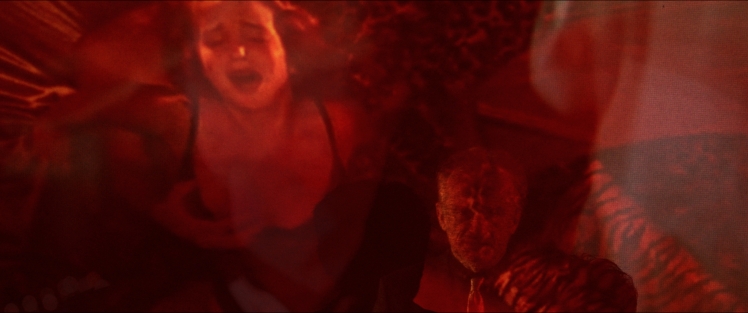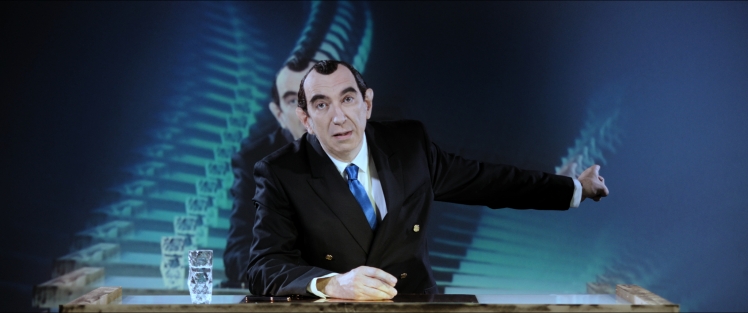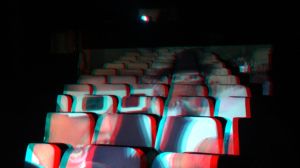 Magnetick Pathways just won 3 awards in the USA :
Magnetick Pathways just won 3 awards in the USA :
- Vortex Grand Prize, for best science fiction/fantasy feature film at the Rhode Island Film Festival in Providence (homeland of cosmic writer Howard Philips Lovecraft, one of the authors quoted in Magnetick Pathways)
- Dominique Pinon -Best actor at Infest New York Film Festival
- Best Experimental film at the Glendale Film Festival
 January 2019 Pêra INTERVIEW about his film by Eduardo Ego, translated by Luísa Ramos on the occasion of the Rotterdam Film Festival retrofuturospektive:
January 2019 Pêra INTERVIEW about his film by Eduardo Ego, translated by Luísa Ramos on the occasion of the Rotterdam Film Festival retrofuturospektive:
When did the idea of adapting Branquinho da Fonseca’s Caminhos Magnéticos (Magnetick Pathways) come up?
In 2005. I started off with one of the short-stories of the book, A Tragédia de D. Ramon (Don Ramon’s Tragedy), about a father that sees his daughter marry a rich upstart and that makes him question the value of money. I also got inspiration from another story from the same book, O Conspirador (The Conspirator) that is set on the aftermath of a civil war. For the film I wanted to create a background situation where a fascist government was democratically elected and elicited a rebellion against the tyranny and the repression that it imposed. At the time I imagined it as pure fantasy, a futuristic sci-fi dystopia, but 12 years on and it is no longer a fantasy, it is only too real, what with the spread of extremism all over the world. Now it is hyper-realism.
But there is nothing hyper-realistic about the film…
The film doesn’t rally around any “isms”.
 Throughout the film you hear “Money isn’t everything” repeatedly – just like in O Barão (The Baron, another film adapted from a novel by Branquinho da Fonseca), where “I’m in charge here!” was repeated time after time. Don’t you think it might be offensive for people who don’t have or have hardly any money?
Throughout the film you hear “Money isn’t everything” repeatedly – just like in O Barão (The Baron, another film adapted from a novel by Branquinho da Fonseca), where “I’m in charge here!” was repeated time after time. Don’t you think it might be offensive for people who don’t have or have hardly any money?
I wonder if those are the film’s spectators. Do the people who don’t have money go to the movies? Do they even watch public service television? Independent films are seen by a niche audience, by people that have a certain background, a certain culture, even if they are hard up. I think it makes sense to address the huge dependency this society has on money, to make people think about it. Eventually there will be some that see it as a provocation, but even then I think this is a relevant question that should be considered by all.
 But can you imagine a civil war in Portugal? Isn’t that too apocalyptic?
But can you imagine a civil war in Portugal? Isn’t that too apocalyptic?
I don’t know… I believe there is a chance that different armed conflicts might erupt at the same time in different countries, even in western countries. Instead of an all-out World War, local conflicts might break out and trigger a world war, the same way the Spanish Civil War anticipated the Second World War.
 Do you believe that violence is the only answer to an authoritarian State?
Do you believe that violence is the only answer to an authoritarian State?
I also don’t know the answer to that. But let me put it this way; how will those fascist forces react when they lose power in later elections? Peacefully? Maybe not. When a repressive regime is enforced and the basic rights and liberties are taken away, there will always be resistance, and desperate people might tend towards “revolutionary violence”, people for whom the destruction of the planet by evil powers justifies any type of action. I have my doubts about that solution, but I also know that frustration is fuelling rage; frustration with the destruction of the Amazon, the lung of the Planet (or as Terence Mckenna would say, “the vagina of the planet”) the exponential increase in pollution levels and with the loss of basic rights by the workers and the minorities. How do you stop those overwhelming powers that are wrecking our planet?
Well, yes, but how?
Who knows? I don’t offer solutions in my movie but I lay the cards on the table and show different pathways.
 It seems to me that those cards are quite jumbled. Why all the overlaps and dissolves that dominate the surface of Magnetic Ways?
It seems to me that those cards are quite jumbled. Why all the overlaps and dissolves that dominate the surface of Magnetic Ways?
In some films of mine, like for instance, A Janela (Maryalva Mix) [The Window (Don Juan Mix)], the surface is almost entirely composed of jump-cuts, thousands of them, that deconstruct the narrative to convey the sense of fragmented memories. In Manual de Evasão LX 94 (Manual of Evasion LX 94) and SWK4, I used in-camera effects for the superimpositions, that depend on random factors but they were pre-planned accidents.
I only really started thinking about image superimposition as a tool in post-production when I was editing Rio Turvo, the first of three adapted screenplays from Branquinho da Fonseca’s novels and short-stories I worked on, mostly because Branquinho’s writing is fluid, he creates mental scenarios with his words.
In The Baron the superimpositions are a way to avoid the shot/countershot routine, the usual ping-pong between the characters. These overlaps and dissolves induce hypnotic states. But I wanted to go further in Magnetick Pathways; by superimposing two or more shots I wanted to convey Raymond’s inner struggle, the conflicting thoughts that are tearing him apart. His existential dilemma.
 Isn’t that something kind of rationalization, something you thought only after the film is finished?
Isn’t that something kind of rationalization, something you thought only after the film is finished?
I don’t think so, but there are more important factors involved in these decision make a film with all those superimpositions. I never know exactly what a film will end up like, there is always something that only becomes clear at the very end, so anything I say about my films after they are finished is influenced by all these processes. I only know that when I was editing the film I wasn’t happy with the cuts, I wanted the film to be like an unstoppable stream, something fluid and overwhelming. A cine-tsunami! This approach was dictated by instinct and I believe it is the best suited to the images and sounds that I created.
 Don’t you think you run the risk of submerging the spectators in a tidal wave of images and sounds?
Don’t you think you run the risk of submerging the spectators in a tidal wave of images and sounds?
We all run that risk, the spectators and myself. We must let ourselves be engulfed by the images and not be afraid to breathe underwater. I concede that it is a difficult film to absorb. But I believe that once the spectators – or at least the ones that have a sensibility closest to my own – overcome the initial resistance to the formal device, they will be able to enter a singular universe, an inhabitable space – despite it being two-dimensional – a place they never saw or experienced before. Recently, I red an interview with Lars von Trier where he said that he conceived the films that had not been made yet. I am interested in making films that fulfil me, or rather, that complete my work. I see each film as a missing part that fits into another missing part until you get the whole picture. And anyway there are sequences in the film that are not superimposed; when Raymond’s thoughts are interrupted by an external action, such as in the interrogation or the return to the wedding, then you have a straight cut from one shot to the next. Nothing is arbitrary in my films, but everything depends on my sensitivity and my notion of harmony.
 Aren’t you afraid of being called a kino-formalist or a cine-fetishist?
Aren’t you afraid of being called a kino-formalist or a cine-fetishist?
I consider many of my films ticking time bombs, or riddles to be deciphered. I have always made films that can’t be decoded in a single viewing.
Doesn’t that keep the people away? Isn’t it pretentious to think that people will return to see the film once more?
I don’t have a clue. I tend to revisit the films I like the most and I accept them as they are, without trying to understand everything the first time. They are like the interesting people you meet, their allure goes beyond a first conversation. I like to think that I make movies for curious and open-minded people, independently of the opinion I might have of them, which is always subjective anyway. Movies should appeal to spectators of all times, from the past (the cinephiles), the present (the public in general) and, above all, the future, because this is where anyone desires their work to be seen and remembered.
 Don’t you think that the formal device you employ is a way to conceal the narrative?
Don’t you think that the formal device you employ is a way to conceal the narrative?
I cannot disassociate the so-called “formal” aspects from the so-called “contents” or subject-matter. A different plot would call for a different formal device. My films don’t really resemble each other except for the eventual strangeness that most of them provoke. Different problems ask for different solutions; like my friend Alberto Pimenta says in my film O Homem-Pykante (The Spicy-Man)“I have a style that is to not have just one single style”. Magnethick Pathways deals with different issues with so many layers… If I had made a simpler, more linear film, it would certainly be labelled as a handout, cheap indoctrination, and I’m not interested in making propaganda films. When Dominique Pinon saw the rough cut he said the film was like an acid trip. It remains to be seen which kind of trip, that is entirely up to the spectator.
 Don’t you think there is something manipulative in that position?
Don’t you think there is something manipulative in that position?
If you mean that I manipulate yhe material of my films, yes, of course I do, but on what concerns the spectator of my films, there is a much wider scope for interpretation than in neorealism or neo-neorealism or Hollywood-type films. I discover the language of my films at different moments; I have “visions” while I’m in the process of writing, at this stage still in the realm of the collective “cinephile mind”, I can imagine the scenes but in a very archetypical – I would even say platonic – sort of way. When we are shooting I discover another, more tangible language for the film. The reason why I refuse to have a treatment completed before I am at the set with the actors, is because I believe that it is important to have time to adapt to the novelty of being in the set, only then I know how I want to shoot a scene.
 I don’t always have the time I would like to have, but this is the method I found for surprising and amazing myself and not just dishing out and recycle ideas from others. In order to make the films “that have not been done” it is necessary to think anew, and as far as I am concerned, this new way of thinking comes from being on the set with the actors, the raw materials; I prefer this method by far to executing a set of pre-planned ideas, even if those ideas are my own. I am not interested in rigid mind-sets, I always prefer to have a less rigid, more “organic” approach to filmmaking. It is only possible to picture a film of mine in a dynamic way, the synopsis are of little use, it is essential to “live” the film in order to understand it.
I don’t always have the time I would like to have, but this is the method I found for surprising and amazing myself and not just dishing out and recycle ideas from others. In order to make the films “that have not been done” it is necessary to think anew, and as far as I am concerned, this new way of thinking comes from being on the set with the actors, the raw materials; I prefer this method by far to executing a set of pre-planned ideas, even if those ideas are my own. I am not interested in rigid mind-sets, I always prefer to have a less rigid, more “organic” approach to filmmaking. It is only possible to picture a film of mine in a dynamic way, the synopsis are of little use, it is essential to “live” the film in order to understand it.
And editing is not just putting sequences together. It is in the editing phase that I discover the true language of the film (that is, if indeed films have a language, as Jan Distelmeyer questions in my next movie, Klnorama), a language that is the result of my early vision and of the beautiful errors (Guy Maddin calls them “happy accidents”) made during the shooting of the film. And thanks to some of these errors I see myself in the position of having to find unconventional solutions to common problems that come up when directing a film. Ultimately, I only discover the true nature of the film the day it is projected in front of an audience. I don’t need their opinions but I have to feel them to know finally what I think about the film.
 What would you say to those that call your films “experimental”?
What would you say to those that call your films “experimental”?
To label a film as experimental might seem innocuous at first sight but it isn’t. This label implies that the object does not classify as a “normal” film. Maybe it would be better to call certain films abnormal, as in “outside the norm”. One of the reasons why I accepted making the portuguese “blockbuster” Virados do Avesso/Upside Down was to prove that I could make a “normal” film that appealed to “normal” spectators. I wanted to show the people that think of my films as abnormal that their difference is not a fault but a quality. Anyway, I just end up doing things in a more oblique way because I know I would get really bored if I tried to replicate narrative methodologies that come from the nineteenth century.
Deep down we are still hooked onto the platitudes of linear narratives, both in the movies and on television. Some spectators can only absorb one image at the time, and look at simultaneous actions on the screen as if they were watching a fireworks display.
 But I am only following leads that have been going around for quite some time – the theory of relativity, cubism and other avant-garde movements of the early twentieth century. There is no excuse to come up today with an artwork that fits into the cannons of Naturalism, or Neorealism, in any of its forms.
But I am only following leads that have been going around for quite some time – the theory of relativity, cubism and other avant-garde movements of the early twentieth century. There is no excuse to come up today with an artwork that fits into the cannons of Naturalism, or Neorealism, in any of its forms.
Hollywood also has the same kind problems with film language, even in the science fiction and fantasy film genres. The idea of cinema as a “window to reality” still prevails. But which reality are we talking about? Whose reality?
I try out several things before and after shooting. Sometimes, when I’m editing, I follow what I know beforehand to be a dead-end, just to test the material’s resistance and see where I don’t want to go. Then I opt for something more definitive; it’s a path without certainties but with a well defined outline. It’s I&D Cinema. Maybe the best word to replace the fated “experimental” is “experiential”. I am interested in having the spectator enter an organic universe and experience an artwork as something he or she can inhabit, that he or she can visit. Maybe spectators are no longer interested in experiencing alternative paths, without their GPSs and gadgets. But I still prefer the Magnetick Pathways.































